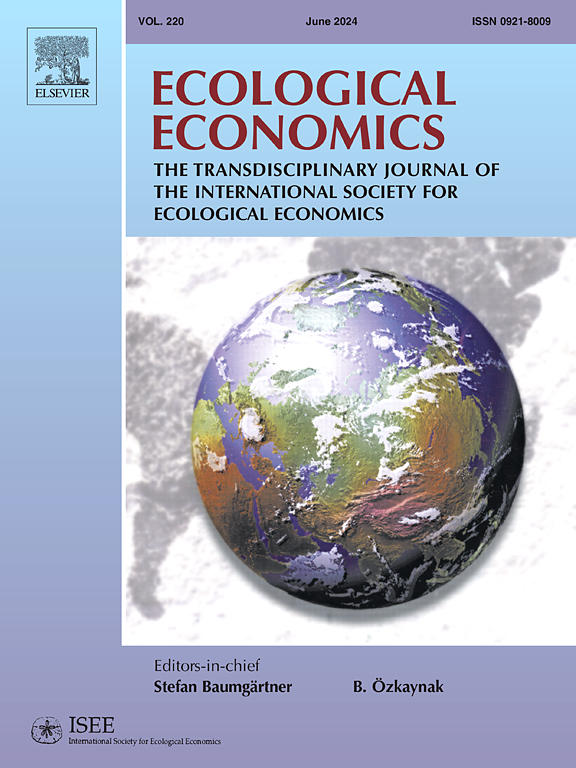Pollinator declines, international trade and global food security: Reassessing the global economic and nutritional impacts
IF 6.3
2区 经济学
Q1 ECOLOGY
引用次数: 0
Abstract
The decline in biodiversity is threatening the provision of vital ecosystem services such as animal-mediated pollination services. While about 17 % of the global crop production value depends on pollination services, these crops make up an even larger share—28 %—of global agricultural trade. This reflects their strong international demand and higher tradability compared to other agricultural commodities. Hence, global trade needs to be considered when assessing how pollinator population declines affect the availability of micronutrient-rich foods and economic welfare in net-importing and exporting regions. This paper critically reviews and extends a global partial equilibrium model covering about 120 edible crops across 22 regions while also capturing international trade. The replication efforts reveal significant methodological and empirical flaws in an earlier, comparable study. Most recent bioeconomic data on crop yield dependence on pollination services are used to simulate a global pollinator collapse. Crop prices are projected to rise by 30 %, leading to a global welfare loss of 729 billion USD, or 0.9 % of global GDP and 15.6 % of global agricultural production value used for human food in 2020. The revised model also reports substantial declines in food production and micronutrient availability such as an 8 % reduction in global Vitamin A availability. These estimates by far surpass previous estimates that were based on earlier bioeconomic data. The findings highlight the critical need for more robust modeling frameworks to inform policy decisions regarding the sustainability of agri-food systems.
传粉媒介减少、国际贸易和全球粮食安全:重新评估全球经济和营养影响
生物多样性的下降正威胁着重要生态系统服务的提供,如动物传粉服务。虽然全球作物产值的17%依赖于授粉服务,但这些作物在全球农业贸易中所占的份额更大(28%)。这反映了它们强劲的国际需求和与其他农产品相比更高的贸易能力。因此,在评估传粉媒介数量减少如何影响富含微量营养素的食物的供应和净进出口区域的经济福利时,需要考虑全球贸易。本文批判性地回顾并扩展了一个全球部分均衡模型,该模型涵盖了22个地区约120种食用作物,同时也涵盖了国际贸易。复制的努力揭示了早期可比研究中显著的方法和经验缺陷。关于作物产量依赖传粉服务的最新生物经济数据被用来模拟全球传粉者的崩溃。预计到2020年,农作物价格将上涨30%,导致全球福利损失7290亿美元,占全球GDP的0.9%和全球用于人类食物的农业产值的15.6%。修订后的模型还报告了粮食产量和微量营养素供应的大幅下降,例如全球维生素A供应减少了8%。这些估计远远超过了以前基于早期生物经济数据的估计。研究结果强调,迫切需要更强大的建模框架,以便为有关农业粮食系统可持续性的政策决策提供信息。
本文章由计算机程序翻译,如有差异,请以英文原文为准。
求助全文
约1分钟内获得全文
求助全文
来源期刊

Ecological Economics
环境科学-环境科学
CiteScore
12.00
自引率
5.70%
发文量
313
审稿时长
6 months
期刊介绍:
Ecological Economics is concerned with extending and integrating the understanding of the interfaces and interplay between "nature''s household" (ecosystems) and "humanity''s household" (the economy). Ecological economics is an interdisciplinary field defined by a set of concrete problems or challenges related to governing economic activity in a way that promotes human well-being, sustainability, and justice. The journal thus emphasizes critical work that draws on and integrates elements of ecological science, economics, and the analysis of values, behaviors, cultural practices, institutional structures, and societal dynamics. The journal is transdisciplinary in spirit and methodologically open, drawing on the insights offered by a variety of intellectual traditions, and appealing to a diverse readership.
Specific research areas covered include: valuation of natural resources, sustainable agriculture and development, ecologically integrated technology, integrated ecologic-economic modelling at scales from local to regional to global, implications of thermodynamics for economics and ecology, renewable resource management and conservation, critical assessments of the basic assumptions underlying current economic and ecological paradigms and the implications of alternative assumptions, economic and ecological consequences of genetically engineered organisms, and gene pool inventory and management, alternative principles for valuing natural wealth, integrating natural resources and environmental services into national income and wealth accounts, methods of implementing efficient environmental policies, case studies of economic-ecologic conflict or harmony, etc. New issues in this area are rapidly emerging and will find a ready forum in Ecological Economics.
 求助内容:
求助内容: 应助结果提醒方式:
应助结果提醒方式:


